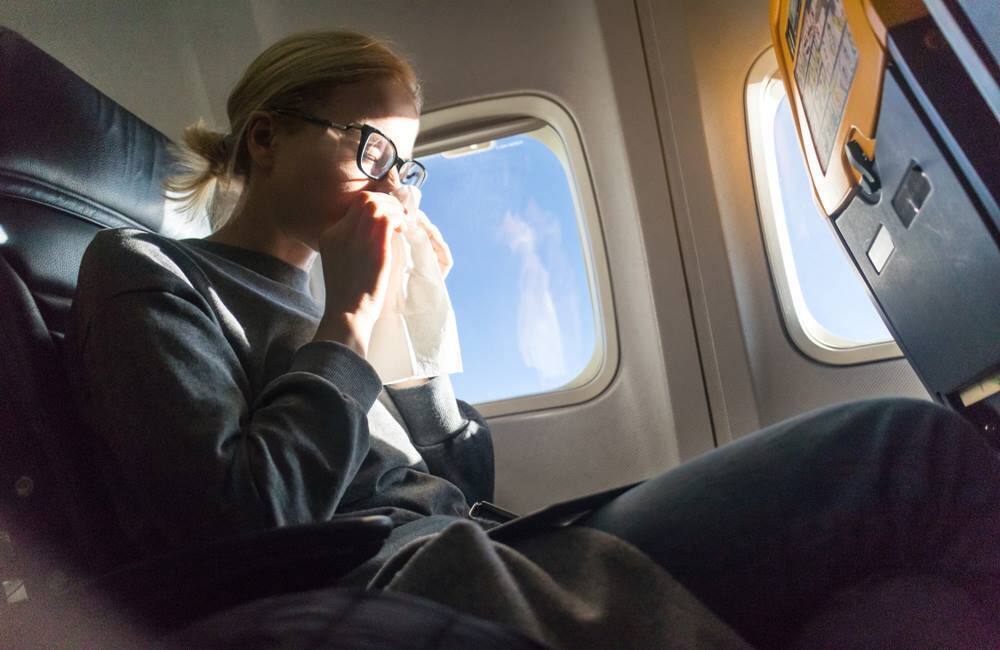
There are typically three reasons why someone in a house gets sick. They are because one member of the household:
- Still goes to school, which is a germ factory without equal
- Works in an office where the boss frowns upon people calling in sick, leading to creation of a germ factory
- Just took an airplane flight
It doesn’t take Alexander Fleming to know that airplanes are a petri dish of germs. People from across the country and around the world, all crammed into a compact area, and who knows which ones go to school or what kind of horrible “you’re not really sick” bosses they have?
Now comes the part where we remind you that sneezes can travel 200 feet, if not covered at the source. Ugh.
Still, plenty of seasoned travelers fly all around the planet and don’t get sick. How do they do it? By reading tips like the ones you are about to read.
Don’t Use the Bathroom
Right before passengers line up to board your flight, use the bathroom at the airport. Don’t drink tons of water before your flight. The reason why is that airplane bathrooms are used by, well, everyone. And germs tend to gather on the sink, toilet seats and door handles. If your flight is short enough, avoid the bathroom.
Drink Water, Not Coffee or Alcohol
You do want to drink water once you get in the air, though. The reason why so many people pick up colds – in addition to the close quarters with many other people – is that the humidity in the air is far lower than what our bodies are used to on the ground. Membranes in the nose and air passages can dry out, making you more susceptible to bacteria and viruses. Water will keep you hydrated and those membranes moist. Coffee and alcohol will dehydrate you, so avoid them.
Keep Hands Clean
The bacteria that causes colds and flu can live for hours on skin, seatbacks and chair arms. Then you touch them. Then you eat some peanuts with your fingers. Then, you’re home with the flu a few days later. It’s always a good idea to keep your hands clean, especially on a plane. Use hand sanitizer or wash with warm, soapy water.
Don’t Touch Your Face
Yes, this is what you tell kids in certain situations. But it really works on airplanes, too. Biting your nails, eating with your bare fingers, scratching your nose – all this provides a really easy transport system for any bacteria or viruses that get past your hand washing or sanitizing. Don’t make it easy for them.
Use the Air Vent
Ever notice the seasoned business traveler who always turns on the air vent and has it blow on her? That’s to blow any airborne germs away from her face. And that’s a smart thing to do. As we indicated in our 2016 article “Airline Air Quality” on average, cabin air is completely refreshed 20 times per hour, compared with just 12 times per hour in an office building. On most aircraft, air is also circulated through hospital-grade HEPA filters, which remove over 99% of bacteria, as well as the airborne particles that viruses use for transport.
If You’re Injured
You especially want to follow all these rules if you are injured. Fortunately, by working with the airlines or hiring a professional non-emergency medical transport company, you can get assistance in getting a seat that is the most comfortable, staying hydrated, and managing your health needs during the flight. For other tips on traveling while injured, look here.
Let’s face it. There’s no guarantee you won’t get sick on a plane. But these tips help thousands of people get through a flight with no problems. Just be prepared and you have a better shot at arriving at your destination bacteria and virus free. Traveling with a medical condition or injury doesn’t have to be a daunting challenge. At Flying Angels, we’re committed to providing the care and expertise you need to travel safely and comfortably.
Ready to discuss your travel needs? Contact us today. Our team of medical travel experts is here to support you every step of the way, ensuring your journey is smooth, secure, and free from stress.
